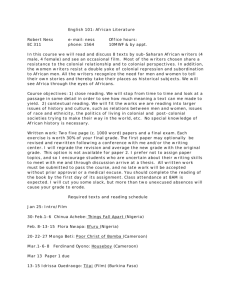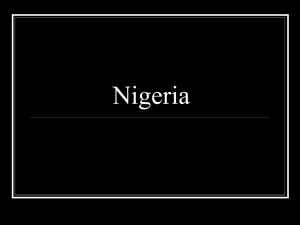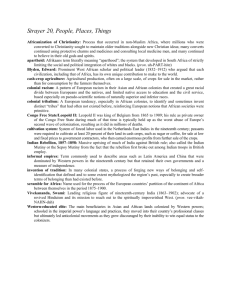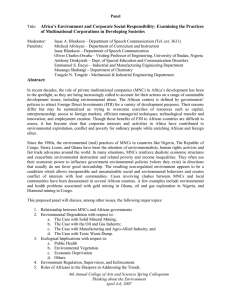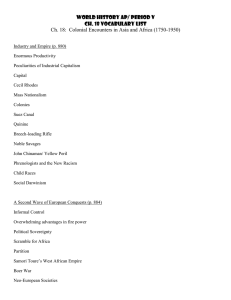SUB-SAHARAN AFRICA (CHAPTER 6)
advertisement
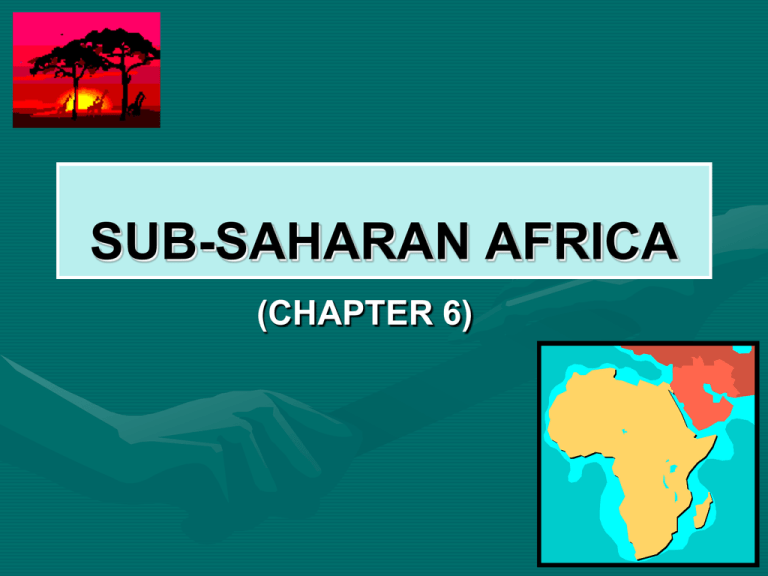
SUB-SAHARAN AFRICA (CHAPTER 6) MAJOR GEOGRAPHIC QUALITIES • Comprised of dozens of countries and hundreds of ethnic groups • 48 countries in Africa (42 in Sub-Sahara, 6 in N/Africa) • A plateau continent that is physiographically unique • A realm of subsistence farmers • Inefficient state boundaries represent colonial legacies • Dislocated peoples and refugees • Great resource potential and raw materials AFRICA’S PHYSIOGRAPHY: Rift Valley Kilimanjaro Major Rivers (Nile, Congo, Niger) Sahara Desert, Plateaus, rainforests This map shows North Africa also. CLIMATE VEGETATION EARLY CULTURE HEARTHS EARLY KINGDOMS The Ruins of the Great Zimbabwe (also, pg 300) CULTURAL PATTERNS • Religions – Christianity (next slide) – Islam (see transition zone slide & pg 338, 312 & 309) – Traditional religions • Population distribution (further slides) • African languages – Lingua franca (define) – Multilingualism • Urbanization (later discussion) AFRICAN TRANSITION ZONE • SAHEL REGION – ‘Sahel’ is the Arabic word for ‘border’ or ‘margin’. • A zone where people are ethnically African but culturally Arab (behave/live like Arabs, even though they are black Africans). • NORTH VERSUS SOUTH – creates Muslim vs. Christian patterns in countries, leading to cultural and political instability e.g. Sudan. • DESERTIFICATION – principal environmental problem in the African Transition Zone. AFRICAN TRANSITION ZONE POPULATION DISTRIBUTION Broad Language Groups There are over 1000 individual languages, in addition to dialects* *Note the difference btw the 2 Also, Lingua Franca Of the 50 largest cities in the world, 5 of them are in Africa (Also, pg 311) Beware of percentages; they can be skewed, based on WHAT NUMBER it takes to BE a City. Africa has more cities than you see. The “Dual City” Phenomenon • Most African cities tend to be “dual cities”. This is mainly as a result of the presence of a traditional city center and colonial/modern city (Western) city center in existence within the same city. • So, most large cities in Africa tend to have “two downtowns” – the traditional and Modern. • This phenomenon was first recognized by Professor Mabogunje (1968), at the University of Ibadan, Nigeria. Modern Cairo, Egypt (Africa) Lagos Skyline, Nigeria Some problems of urbanization in Africa – urban primacy, housing, sanitation, traffic, unemployment, inadequate services, etc. – same as everywhere in South America or Asia. THE ATLANTIC SLAVE TRADE COLONIALISM • European Colonial Objectives – Ports along the West African coast – Water routes to South Asia (India) and Southeast Asia – 1500’s- looking for resources and slaves – 1850- Industrial Revolution occurs in Europe • Increased demand for mineral resources • Need to expand agricultural production BERLIN CONFERENCE 1884 • 14 European States divided up Africa without consideration of existing cultures (pg 305) • Results of superimposed boundaries ------ African peoples were divided. Unified regions were ripped apart. Hostile societies were thrown together. Migration routes were closed off. Old inland traditional cities were ‘ignored’ and declined. • When independence returned to Africa after 1950, the realm had already acquired a legacy of political fragmentation. UNIQUE COLONIAL POLICIES • Great Britain: In some sub-regions, “Indirect Rule” was practiced (Ghana, Nigeria, Kenya, Zimbabwe) – Indigenous power structures were left intact to some degree (especially in the Muslim north) and local rulers were made representatives of the crown. Led to unequal development and later conflict. • France: “Assimilationist” (Senegal, Mali, Ivory Coast, Togo, Benin Rep. etc.) – Enforced a direct rule which propagated the French culture through language, laws, education and dress (acculturation) COLONIAL POLICIES • Portugal: “Exploitation” (Guinea-Bissau, Angola, Mozambique) – Was first to enslave and colonize and one of the LAST to grant independence – Maintained rigid control; raw-resource oriented • Belgium: “Paternalistic” (Rwanda, Democratic Rep. of the Congo [Zaire], Burundi) – Treated Africans as though they where children who needed to be tutored in western ways; did not try to make them Belgian, but tortured them, instead. The WORST colonial system. See video, and pg 305. – Raw-resource oriented; ignored the development of natives THE LEGACY • Sometimes, several hundred languages are spoken in each country. • Antagonism between ethnic groups (e.g., Rwanda, Nigeria, etc) • Low level of development is linked to colonization – Communication Africa is naturally impeded by desert, dense forest, and lack of navigable rivers in certain regions (rapids and waterfalls). – Transportation facilities – However, the colonialists were only interested in the movement of goods from the interior to coastal outlets, hence the odd railway designs in Africa. See pg 317. – Dual economy (i.e. local & export) remains intact, as it was during colonial times. Most States rely on a single crop or mineral and are vulnerable to world markets (as you find in other former colonies around the world). INDEPENDENT STATES IN SUBSAHARAN AFRICA (PG 306) Supranational Organizations in Africa – Southern Africa Development Community (SADC), African Union (AU), ECOWAS, etc MEDICAL GEOGRAPHY • Studies spatial aspects of disease and health • E.g.: -- Disease incidence and diffusion -- Widespread nutritional deficiencies • In Africa, millions suffer from: – Malaria - River Blindness – Yellow Fever – AIDS - Sleeping Sickness - Bilharzia REGIONS OF SUBSAHARAN AFRICA WEST AFRICA NIGERIA • At independence, Nigeria was composed of three regions (based on regional ethnic bases of the Hausa-Fulani, Yoruba, and Ibo). Hausa-Fulani Yoruba Colonial Development (West) Ibo Muslim Dominated (North) Densely populated rural areas (East) NIGERIA • In 1967 interregional rivalries led to civil war when the eastern region tried to secede as Biafra. • Regions have been subdivided and rearranged to ensure a civil war does not occur again (hopefully). • Currently - a Federal State under an elected government • Capital city moved from Lagos to Abuja (1992) NIGERIA REGIONS OF SUBSAHARAN AFRICA EQUATORIAL / CENTRAL AFRICA Astride the equator Mainly lowland countries Vast areas of rainforest EQUATORIAL AFRICA • Delineated from Nigeria by physiographic as well as cultural breaks. • The Adamawa Highland coincides with the border between British-influenced Nigeria and Frenchacculturated Cameroon. EQUATORIAL AFRICA - Regional Features • Dominated by Congo River and Basin – Equatorial rainforest – Impeded in transportation and communication • French is predominant in most states except Sao Tome and Principe • The most underdeveloped region in this realm • Resources – Copper (Democratic Republic of Congo) – Timber, oil (Gabon, Cameroon) – Gold, manganese and uranium HORN OF AFRICA Includes Old Kingdom of Kush (Ethiopia) EAST AFRICA Lies astride the equator Mainly highlands Cooler and generally drier conditions prevail Ethnic diversity EAST AFRICA - Kenya • • • • • • Dominant state in region Capitalist approach to development Nairobi (3.0 million) Coffee, tea, tourism revenues Swahili is the lingua franca 1980s - world’s fastest growing populations SOUTHERN AFRICA This is a region; it’s not the same as “South Africa” – the country. 10 countries (Madagascar? See pg 322) 6 landlocked states Northern zone marks limit of Congo basin Plateau country Rich in natural resources Agricultural diversity SOUTH AFRICA (the country) SOUTH AFRICA
